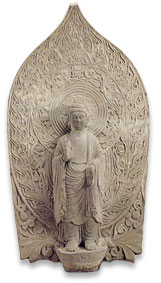
![]()
 |
| Buddha, stone, Northern Qi, A.D 550-577. |
2007 Chinese Art History Distinguished Scholar Award Conferred by The American Friends of the Shanghai Museum, March 20, 2007
I think on such occasions one should reminisce a little and think ahead a little. About thirty years ago I was reading Kenneth Clark's autobiography (or the first of two), then just published, called Another Part of the Wood. I was struck by one line fairly early on in this book, in which he said: "My whole life might be described as a long, harmless confident trick." I thought then, what a wonderful way of being modest. Thinking back now, it may have been more than that. There might have been a hidden meaning, conscious or not, behind that statement. He might have had a premonition that times were going to change and the approach to art history was about to change as well. Perhaps that is what is behind the rather unexpected quote (from W. B. Yeats) he made at the end of his book, Civilization: "The best lack all conviction, and the worst is full of passionate intensity." Kenneth Clark may nor may not have known Adorno and the critical theorists and that "theory" was about to take over the field of art history — at least in academia, and that those of us who continue to work in museums would find ourselves in a state of siege, with theoretical art history on one side and crusading archaeologists on the other. How that is going to end, I shall not predict. I can only hope that eventually there will be some degree of mutual accommodation. Otherwise, the prophets who proclaim the end of art history, and that of art altogether, will have their prophecy fulfilled.
Closer to our own field of Asian art history, and that of Chinese art in particular, there is another kind of schism—and it has a long history. About this time, in the last century, there were two people with good claims to be experts in Chinese art. One was John Ferguson, who lived in China, was learned in Chinese, and acted as advisor or consultant to the Metropolitan Museum. Many paintings that entered the Museum’s collection in the early 20th century were recommended by Ferguson, or otherwise sold or given by him. There was Charles Freer who collected on his own account and was consulted by other collectors and museums. Now, their respective approaches to the collecting of Chinese paintings were very different. For Ferguson, if you did not know the Chinese language and literature and could not consult with ease all the catalogues of Chinese collections, particularly those of more recent centuries which recorded each painting and calligraphy in great detail, you are not qualified to collect Chinese paintings. Freer, on the other hand, thought that aesthetic judgment was paramount. If you could not tell the authenticity of a painting by its quality and the period by its style, you should not collect at all. (I have grossly exaggerated their positions for the sake of brevity.) The two of them engaged in a vigorous debate, sometimes public and sometimes acrimonious. It is a particular case of a dichotomy discussed in more general terms by John Pope, Director of the Freer, in a paper (published about 50 years ago) called Sinology or Art History. The problem as stated by Pope remains today. It has been perpetuated by historical events which caused the isolation of China for a period of about half a century. Many Chinese even today think that if you are not brought up in China and steeped in Chinese culture, you can never understand Chinese art. Those who work outside China think that the critical deficiency in the Chinese approach to the study of art is the lack of art history as an academic discipline—and by that I do not mean that the kind of art history that is being practiced at universities in the US and in Europe. It is organizations like the American Friends of the Shanghai Museum that will help to bridge this gap of understanding by providing opportunities for Chinese scholars to visit the States, and eventually we can all work together to mutual benefits. As the great Chinese scholar Wang Guowei, who lived at the end of the Qing dynasty and the beginning of the Republic famously said, "There is no such thing as Western scholarship and no such thing as Chinese scholarship, there is only scholarship."
I should like to thank the members of the Council of the American Friends of the Shanghai Museum, for the honor they have bestowed on me. But as we all know, museums work in teams, and although I should like to take credit for myself, all I have done is to participate in the work to which every member of the Department of Asian Art contributes. And I have to thank also my colleagues for allowing me to take the credit on behalf of them all. And finally, thank you all for coming this evening.
James C. Y. Watt is
the Brook Russell Astor Chairman
Department of Asian Art
Metropolitan Museum of Art
Distinguised Scholar Award - Directors - The Shanghai Museum - Contact Us